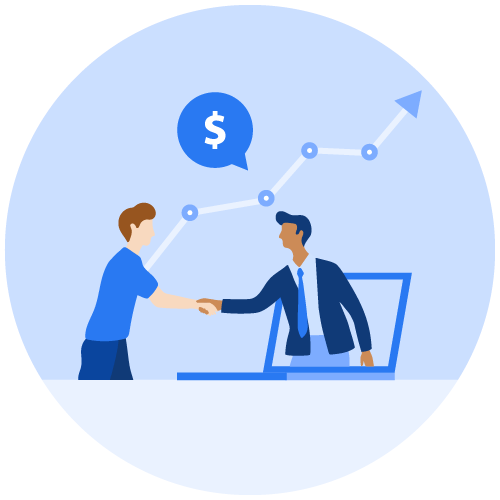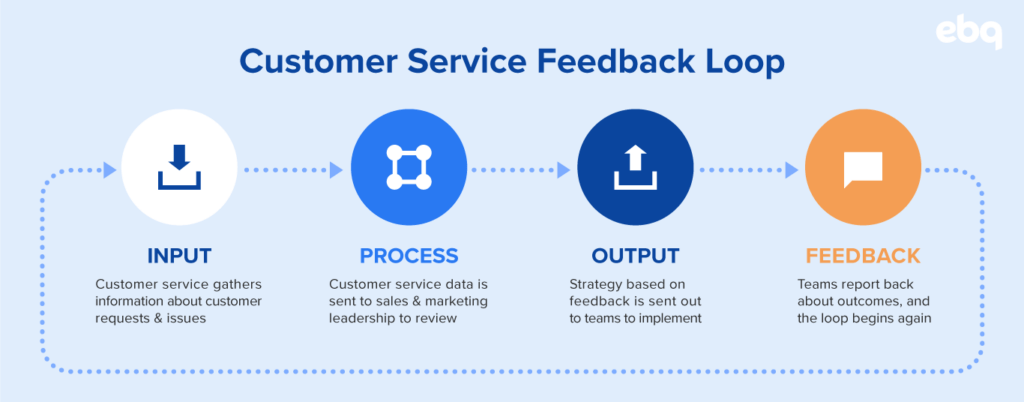How to Increase Sales Revenue with Customer Service


Dalia Arroyo
It’s no secret that providing excellent customer service is paramount for retaining customers. As a result, most of us think of it solely as a post-sale function.
The truth is that supporting existing customers can be an effective way for companies to increase sales revenue. Instead of treating support as the end of the customer journey, treat it as an opportunity to restart and recharge the customer cycle.
Let’s look at some practical ways that customer service can contribute to your bottom line and how you can increase the total value gained from your customers.
Increase customer lifetime value
Great customer service creates a relationship built on trust and appreciation, which often evolves into customer loyalty and increases the amount buyers are willing to spend on your product or service.
Techniques you can use to increase the overall lifetime value of your customers include:
- Sending renewal reminders leading up to and after the renewal date
- Reaching out to past customers to re-engage them with your company and service
- Up-selling and cross-selling by suggesting ways customers can increase functionality based on their priorities
Starting with the obvious, customer retention is the biggest opportunity to increase revenue through customer service. In fact, growing your customer retention rate by just 5% can increase profits by more than 25%, according to research by Bain & Company.
You don’t want to lose the customers you spent so much time, money, and effort working to convert. And you surely don’t want to see them switch over to your competition.
A rather alarming statistic Bain & Company discovered says that your customers are 4x more likely to buy from competitors after experiencing a service-related issue, versus an issue with the product or price.
It’s apparent why you need to make a lasting impression and position yourself as a superior support provider. Positive customer experiences not only have the power to retain customers but also the potential to bring lost customers back.
As first-rate support becomes more of the expectation as opposed to the exception, customers are inclined to give their business to the company who provides an effortless and satisfying customer experience.
Sometimes all you have to do is ask
What do you do when you have 250 contracts up for renewal and only 2 months to secure them?
Asure Software, with the help of EBQ, used Customer Service Specialists to call on each customer for a renewal reminder and rundown on the process and pricing.
It was a small, but personal, gesture of good customer service that helped Asure Software retain 80% of their customer base.

Superior customer service means listening to and understanding your customers, their needs, and how you can meet those needs. And when you begin to understand your customers, you will come across opportunities to increase value for both sides of the relationship.
Up-sell and cross-sell added features, accessories, and services that can better meet their needs. You’ll find that many customers don’t mind paying an extra premium when they are satisfied with the benefits and support they receive.
Turn customer advocacy into referrals
Brand advocates are customers who willingly refer your company to friends and colleagues for little or no incentive, simply because they are pleasantly surprised by your product and, most often, the support you provide for it.
Treating customer service as an integral part of the buyer’s journey, instead of the finish line, is a productive step toward creating brand advocates out of your customers.
Customers in the “delight” stage of their journey are the ones you want to focus on for advocacy. Outstanding customer service often provokes the most emotional response to your offering, especially in B2B industries where most exchanges are technical or business-oriented.
How can you provide delightful support and encourage customer advocacy?
- Supply reps with a central knowledge base, so customers always receive accurate, consistent information
- Give reps the liberty to “go the extra mile”—even the smallest act of kindness can lead to a positive and memorable experience when it’s unexpected
- Always respond as quickly as possible and make support available across channels (42% of customers prefer chat support)
- Reward customers with loyalty programs, discounts, and promotional offers
- Document all customer interactions somewhere that is accessible to each team, like your CRM, so your internal strategies can be based on direct customer feedback
- Hire friendly, polite reps and make sure they’re well-trained in conflict resolution
Many of these tactics require a process of trial and error to figure out the best way to apply them for your customers and support organization. Always look at the costs of improving and scaling your customer service organization versus the expected effects on customer satisfaction and advocacy it will have.
For example, if you’re a small business with an undeveloped support team, or even have your product developers answering customer requests, it may not be feasible to provide support across channels or even keep up with request volume.
Situations like this cause many businesses to consider outsourcing customer service, often to large offshore BPO companies. If you’re in a situation like this, know that there are better options for better quality support.
EBQ has helped thousands of clients provide better customer experiences. Whether or not you choose EBQ, if you’re thinking of outsourcing your customer support, partner with a company who will work with you to develop procedures customized to your strategy and customer base.
How do you get customer referrals?
If you’re able to delight your customers and help them succeed with your solution, you are already well on your way to earning referrals from your existing customers.

It turns out that 46% of customers who experience positive support interactions tell an average of 11 people about the experience, according to those surveyed in a study by American Express. (But beware—they tell even more people about bad service.)
This word-of-mouth is powerful because nearly half of buyers say they are more influenced to purchase based on a referral, compared to communications coming directly from a company.
Similarly to contract renewals, sometimes all you have to do is ask for a referral. If the customer is happy with your product and support, they’re often willing and happy to do you this favor.
You might also offer customers incentives to recommend your solution to friends and colleagues if it’s cost-effective for your company to do so. Customers will be even more willing to send you referrals if they perceive even a small amount of added value for themselves.
A few ways to elicit and incentivize customer referrals include:
- Ask for referrals or reviews at the end of each call, email, chat interaction, or customer satisfaction (CSAT) survey
- Offer discounts, exclusive offers, and gifts for referring a certain number of people
- Ask customers (or incentivize them) to follow your company on social media, so they’ll be more inclined to mention you, share your content, and leave reviews on those platforms
- Direct customers to referral marketing content like message templates and refer-a-friend forms on your website to make it easier for them to refer people
- If you have B2B customers and you’re a fan of their work or professionalism, leave your clients reviews, and they might be eager to return the favor
- Always thank your customers for referrals and reviews to show you appreciate them and encourage them to send you more

Referrals can turn into some of your best customers. These customers stay longer, spend more, and bring you more business. The statistics on this phenomenon are staggering. Referred customers:
- Are 18% less likely to churn
- Spend 200% more per order than an average customer
- Are 4x more likely to refer others
- Have a 25% higher extended customer lifetime value
Most sales and marketing leaders agree referral leads are a powerful source of revenue.
From referrals, you’re not only receiving a higher customer lifetime value. The cost of acquisition is built into that value as well, allowing you to allocate the money and resources saved toward acquiring even more customers.
Organizational leaders who act on this notion rely on customer service and outstanding customer experiences to bring in these valuable referrals.
Support your sales team
Customer service clearly plays an important role in retaining and growing your customer base. But what about the more indirect role it plays in increasing your sales revenue?
Your customer service organization, when working thoroughly and competently, can act as a support tool for your sales team, helping them close deals with explicit customer insights.
The main ways that customer service helps enable your sales team include:
- Learning from your existing customers about their needs and priorities
- Serving as a compelling selling point for buyers who value customer support
- Providing a positive first brand exposure for prospects routed through support to sales
Perhaps the most functional of these is the feedback loop created from the support team’s direct contact with customers. Customer service agents are on the front lines of the organization, gaining a unique perspective of who the customers are and gathering data with each interaction they have.

“Customer service agents are on the front lines of the organization, gaining a unique perspective of who the customers are and gathering data with each interaction they have.” Click to Tweet!
Every team, sales and marketing especially, should be working with the customer support department to align strategies and messaging that will entice your ideal buyers.
The product team should take customer service’s feedback, both negative and positive, into consideration in order to continuously improve your offering, making it a solution that buyers want to buy. This not only increases sales but also makes customers feel heard and appreciated.
You can make them feel even more appreciated by proactively soliciting feedback via support emails and website forms in order to make improvements that your customers love and show them that you value their opinions.

Both sales and marketing can use the insights gained from customer service conversations to present the most relevant selling points, some of which might not have been recognized as selling points before these support interactions.
And this leads right into our next point about using customer service itself as a selling point. Referring back to the American Express study mentioned above, customers prioritize quality of support and factor it into their buying decisions.
The research found that buyers are willing to spend 17% more to do business with a company that provides excellent customer service, and this figure can be much higher depending on what type of customers buy your product (21% for millennials).
Your salespeople should leverage this prioritization of customer service, emphasizing the pain that comes with competitors’ inconvenient and inconsiderate support methods, in order to close more deals and at higher values.
In many cases, prospective buyers reach out to a customer service team first, instead of sales, to learn more about the product or service. These conversations typically go 1 of 3 ways:
-
- The agent immediately re-routes the contact to the sales team
- The agent obliges, attempting to answer the contact’s questions about how their solution compares to competitors, and the would-be buyer ends the conversation before ever speaking to a sales rep
- The agent explains that they would be happy to help but that the sales team would be able to provide much more accurate answers to their particular questions, asking permission before transferring the contact to sales
Can you guess which scenario is the most productive for everybody involved?
The third option demonstrates both the support agent’s desire to help as well as providing sales an opportunity to pitch the offering’s most enticing aspects. At the same time, the prospective buyer gets the answers they’re seeking as well as a pleasant, empathetic exchange with the support agent.
Revenue may be the ultimate goal, but don’t forget the significant impact your support organization has on that goal.
Customer service is the voice of your company, affecting how customers perceive you and impacting your entire brand identity. Always shoot for quality support, and the revenue will follow.
Conclusion
Recent studies show that customers believe customer service in general is improving, as companies begin to recognize the value that buyers place on convenient, quality support. Focus your support efforts on delighting your customers, and you can expect to see increases in retention, customer advocacy, and—as a result—your sales revenue.
Ensure all teams are working together to better understand and serve your buyers, and don’t hesitate to contact EBQ if you need a hand delighting and retaining all those customers you worked so hard to acquire.

